Allogeneic Stem Cell Transplants
Allogeneic stem cell transplantation (HSCT) necessitates the collection of a sufficient number of stem cells (SC) from a histocompatible donor and their infusion into a patient after a conditioning regimen. HSCT has progressed from an experimental therapy for terminally sick patients to a curative treatment during the last 35 years. In Italy in 2003, 1170 procedures were registered (Italian Group for Blood and Marrow Transplantation).
Leukemia, lymphoproliferative disorders, myelodysplasia, and nonmalignant illnesses such as thalassemia and severe aplastic anemia were the most commonly reported indications.
Significant changes have occurred in the last 5 years, including the shift from bone marrow to peripheral blood as the SC source, an increase in the number of alternative donors such as unrelated, partially matched family donors and cord blood SC, and the addition of new extra-hematological indications such as solid tumors. Furthermore, the discovery of non-myeloablative conditioning regimens has enabled clinicians to conduct HSCT on patients who are elderly or have significant comorbidities.
In contrast, the availability of the Tyrosine kinase inhibitor (STI-571) for the treatment of patients with chronic myelogenous leukemia, which was formerly the principal indication for HSCT, has resulted in a significant decline in the frequency of transplants in this situation. HSCT conducted in the early stages of illness and in young individuals has a cure rate of greater than 50%.
